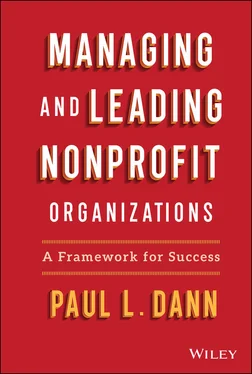Paul L. Dann - Managing and Leading Nonprofit Organizations
Здесь есть возможность читать онлайн «Paul L. Dann - Managing and Leading Nonprofit Organizations» — ознакомительный отрывок электронной книги совершенно бесплатно, а после прочтения отрывка купить полную версию. В некоторых случаях можно слушать аудио, скачать через торрент в формате fb2 и присутствует краткое содержание. Жанр: unrecognised, на английском языке. Описание произведения, (предисловие) а так же отзывы посетителей доступны на портале библиотеки ЛибКат.
- Название:Managing and Leading Nonprofit Organizations
- Автор:
- Жанр:
- Год:неизвестен
- ISBN:нет данных
- Рейтинг книги:4 / 5. Голосов: 1
-
Избранное:Добавить в избранное
- Отзывы:
-
Ваша оценка:
- 80
- 1
- 2
- 3
- 4
- 5
Managing and Leading Nonprofit Organizations: краткое содержание, описание и аннотация
Предлагаем к чтению аннотацию, описание, краткое содержание или предисловие (зависит от того, что написал сам автор книги «Managing and Leading Nonprofit Organizations»). Если вы не нашли необходимую информацию о книге — напишите в комментариях, мы постараемся отыскать её.
Managing and Leading Nonprofit Organizations: A Framework For Success
Managing and Leading Nonprofit Organizations: A Framework For Success
Managing and Leading Nonprofit Organizations — читать онлайн ознакомительный отрывок
Ниже представлен текст книги, разбитый по страницам. Система сохранения места последней прочитанной страницы, позволяет с удобством читать онлайн бесплатно книгу «Managing and Leading Nonprofit Organizations», без необходимости каждый раз заново искать на чём Вы остановились. Поставьте закладку, и сможете в любой момент перейти на страницу, на которой закончили чтение.
Интервал:
Закладка:
For example, rather than simply relying on a quality improvement director, you might develop a peer‐review process that engages interdisciplinary team members from across the organization to share in continuous quality improvement visits, CQI goals, and objectives as well as practices. In this way there are multiple opportunities for employee engagement and leadership development that are built into the organization's practices.
Strategies of this type can be pursued across the organization, covering various agency functions. From continuous quality improvement practices to employee training and development to information technology to events planning, the use of systems that provide the framework for employees of the organization to pursue opportunities to develop their leadership capacity are many. As an individual, watch for these opportunities; as a leader within an organization, strive to optimize the number that are available, knowing that done well these opportunities will build leadership practice across the organization.
Become an Advocate for Leadership Development Practice
As you strive to pursue as well as enhance your organization's leadership and engagement opportunities, I want to be sure that you prepare yourself to become a wholly committed advocate. An advocate not only for your own leadership practice but also at an organizational level as well. Building leadership practice for yourself and for the team is something that must be intentional and the desire to develop yourself and the team around you must be articulated. Advocates give voice to a cause that without their public support might not become a reality. Similarly, you must give voice to the desire to develop your leadership skills. This is true as well for those who hope to grow leadership capacity within the organization.
I recall early on in my career having the flawed belief that if I worked hard and developed myself that someone would notice, and I would be provided with greater leadership responsibility. It did not take long before I realized that no one truly noticed. They did appreciate all that I would do, but simply thought I was content with the status quo and had no idea that I had a vision of where my leadership journey might go. Once I started to say affirmatively that I desired to grow as a leader and have greater responsibility, then people began to intentionally consider how I could contribute to new efforts that would represent a greater and more in‐depth leadership role.
It is also critical to advocate for leadership practice across the entire organization. If you do not articulate the importance of everyone developing their capacity to share in leadership practice, then you will have a hard time establishing an agencywide leadership development perspective. Other norms or patterns of behavior can take hold that could ultimately hurt the agency's capacity to be a place that is vibrant and, as Raelin (2011) would say, Leaderful .
Within organizational life there are multiple places where your advocacy can pay off. Annual evaluations become a time when future goals and professional development can be clearly articulated. If you desire future leadership responsibility and growth this is a perfect place to articulate how you hope to grow. Regular meetings with your supervisor become a natural place to talk about future goals as well as professional growth and development. Consider training opportunities that are geared toward your leadership development, as well.
As you pursue each of these strategies, recall the practice perspectives we explored earlier in this chapter. Be sure to have the long view in mind, do not forget to enjoy the journey, remember to use your compass to stay focused on your True North, and be sure to leverage serendipity. For example, you might say if you write about your desire to have more leadership responsibility in your annual evaluation that your current supervisor will see this as a threat. First, my condolences for having a supervisor with this view, but beyond that recognize that this individual is a point in time in your journey and there are other strategies to pursue in your development. While you will encounter obstacles in your leadership journey, your practice perspectives make it possible to pivot around just such a barrier. We know because we have taken the long view that our tenacious nature will help to overcome each challenge that is encountered.
Find a Mentor
Early on in my career I quickly realized that there was much to learn from more senior leaders within my nonprofit organization. Some of this learning came naturally by observing their approach and style to any number of situations. I learned from their example both what to do and, at times, what not to do. Often my direct supervisor served as a source of leadership development, particularly when I had a supervisor who had leadership strengths. This was ideal because meetings were regularly scheduled and included discussions about various situations that had arisen between meeting times. There were times, though, when my direct supervisor was not someone I felt I could learn from. In these instances, I felt their skills as a leader were lacking. These were the instances where I would typically learn what not to do. A reverse role model, if you will.
When I found myself in this predicament, I realized that I would have to seek support for my developmental leadership journey from someone other than my direct supervisor. It was not too difficult to look around the organization or even outside of the agency to find someone with the skills and expertise in leadership that I could respect. The key was to be intentional about this effort to pursue a mentor who could support my development. There is always a risk that you could become complacent by resigning yourself to the fact that you have a difficult situation with a supervisor, and rather than pursue an external mentor and coach, settle into feeling stuck. Better to be intentional and avoid the cul‐de‐sac of complacency as you work to develop your leadership capability.
I have heard and experienced the idea as well that mentees choose their mentor. If you are to have a mentor, and you should, set about intentionally developing a professional relationship with a colleague or associate whom you respect. In time this respect can form the foundation for building a relationship of trust, support, and learning that in the best of worlds will become reciprocal over time.
The positive impact associated with a true mentor relationship is well documented. Ayoobzadeh and Boies (2020), for example, researched the impact of mentors and found that successful mentor relationships helped to increase positive outcomes for the participants. Now notice that the key term here is successful mentor relationship . It is not enough to simply participate in a structured mentor program within your organization and assume that the mentor/mentee relationship will be defined as successful. There are many variables that come into play when we pursue a successful mentor relationship—not the least of which revolves around the way in which the organization's culture supports the development of mentorships (Johnson & Smith, 2019).
Considerations include whether there is mutually shared respect between the mentor and the mentee. The mentor must be perceived by the mentee as having the skills necessary to play the role in a positive way and even beyond that it is critical that the mentor have the skill set necessary to fulfill the role of mentor. And even if these pieces are in place it's essential that the mentor and the mentee have a willingness to develop and sustain a supportive relationship All these variables and more are at play in the development of a successful mentor relationship.
Читать дальшеИнтервал:
Закладка:
Похожие книги на «Managing and Leading Nonprofit Organizations»
Представляем Вашему вниманию похожие книги на «Managing and Leading Nonprofit Organizations» списком для выбора. Мы отобрали схожую по названию и смыслу литературу в надежде предоставить читателям больше вариантов отыскать новые, интересные, ещё непрочитанные произведения.
Обсуждение, отзывы о книге «Managing and Leading Nonprofit Organizations» и просто собственные мнения читателей. Оставьте ваши комментарии, напишите, что Вы думаете о произведении, его смысле или главных героях. Укажите что конкретно понравилось, а что нет, и почему Вы так считаете.











